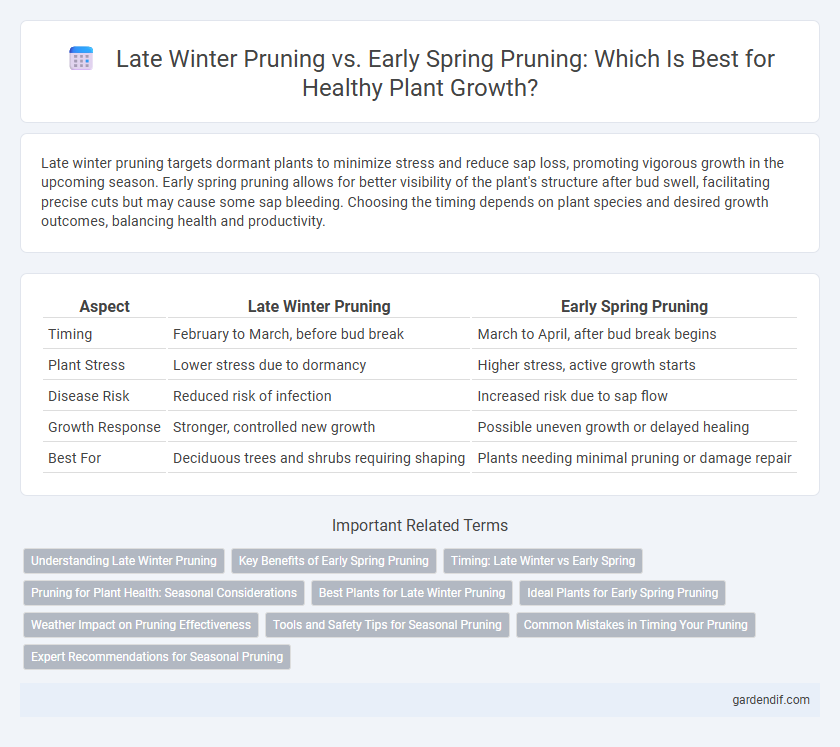
Late winter pruning vs Early spring pruning Illustration
Late winter pruning targets dormant plants to minimize stress and reduce sap loss, promoting vigorous growth in the upcoming season. Early spring pruning allows for better visibility of the plant's structure after bud swell, facilitating precise cuts but may cause some sap bleeding. Choosing the timing depends on plant species and desired growth outcomes, balancing health and productivity.
Table of Comparison
| Aspect | Late Winter Pruning | Early Spring Pruning |
|---|---|---|
| Timing | February to March, before bud break | March to April, after bud break begins |
| Plant Stress | Lower stress due to dormancy | Higher stress, active growth starts |
| Disease Risk | Reduced risk of infection | Increased risk due to sap flow |
| Growth Response | Stronger, controlled new growth | Possible uneven growth or delayed healing |
| Best For | Deciduous trees and shrubs requiring shaping | Plants needing minimal pruning or damage repair |
Understanding Late Winter Pruning
Late winter pruning targets dormant plants just before new growth begins, promoting healthier branch structure and boosting fruit or flower production. This method minimizes the risk of disease by allowing cuts to heal quickly as sap flow increases with warming temperatures. Understanding late winter pruning helps optimize plant vigor and improve overall garden productivity.
Key Benefits of Early Spring Pruning
Early spring pruning promotes vigorous growth by removing winter damage and stimulating healthy bud development. This method enhances air circulation and sunlight penetration, reducing disease risk in fruit trees and ornamental plants. Pruning in early spring also allows for immediate assessment of winter injury, ensuring timely removal of dead or weak branches.
Timing: Late Winter vs Early Spring
Late winter pruning occurs when trees are fully dormant, reducing stress and minimizing sap loss, which promotes vigorous spring growth. Early spring pruning is performed just before bud break, allowing immediate healing but increasing the risk of frost damage and slower wound closure. Optimal timing depends on the plant species and local climate conditions to balance growth stimulation and protection.
Pruning for Plant Health: Seasonal Considerations
Late winter pruning enhances plant health by allowing wounds to heal before the active growth phase, reducing the risk of disease and pest infestation. Early spring pruning stimulates vigorous new growth but may expose plants to damage from late frosts or increased susceptibility to infections. Selecting the appropriate timing based on plant species and local climate maximizes the benefits of pruning while minimizing stress and health risks.
Best Plants for Late Winter Pruning
Late winter pruning is ideal for deciduous trees and shrubs such as apple, pear, and grapevines, as it stimulates vigorous new growth and enhances fruit production. Plants like roses, hydrangeas, and many hardwood trees respond well to this timing because dormancy reduces stress and allows for better wound healing. Compared to early spring pruning, late winter pruning minimizes sap loss and reduces the risk of disease, making it the preferred method for woody perennials.
Ideal Plants for Early Spring Pruning
Ideal plants for early spring pruning include fruit trees like apples and pears, as their dormant buds respond well to the timing, promoting vigorous new growth. Deciduous shrubs such as lilacs and viburnums benefit from early spring pruning by enhancing flowering and maintaining shape. This pruning period minimizes disease risk and maximizes branch visibility, ensuring precise cuts for healthier, more productive plants.
Weather Impact on Pruning Effectiveness
Late winter pruning takes advantage of the tree's dormant phase, reducing stress and exposure to extreme cold, which promotes healthier wound healing and minimizes disease risk. Early spring pruning, conducted as sap flow begins, can increase vulnerability to frost damage and sap bleeding, potentially weakening the plant and hindering growth recovery. Understanding local climate patterns and selecting the optimal pruning time helps maximize pruning effectiveness and long-term plant vitality.
Tools and Safety Tips for Seasonal Pruning
Late winter pruning often requires durable bypass pruners and loppers with sharp, rust-resistant blades to effectively cut through dormant, tougher branches, while early spring pruning benefits from lightweight, precision tools like hand pruners for delicate new growth. Use protective gloves, safety goggles, and ensure tools are clean and well-maintained to prevent injury and disease spread during both seasonal practices. Proper sanitation with disinfectants between cuts reduces risks of cross-contamination, promoting healthier plants across pruning cycles.
Common Mistakes in Timing Your Pruning
Pruning too early in late winter can expose plants to frost damage, while delaying until early spring risks removing developing buds essential for growth. Common mistakes include misidentifying the plant's dormant period and ignoring local climate cues, both leading to reduced flowering or fruiting. Proper timing aligns with the plant's natural cycle, maximizing health and productivity.
Expert Recommendations for Seasonal Pruning
Expert recommendations for seasonal pruning emphasize late winter pruning to reduce the risk of disease and promote vigorous spring growth by allowing cuts to heal before active growth begins. Early spring pruning is advised mainly for removing damaged or diseased wood after cold snaps, enhancing overall plant health. Both techniques are tailored to specific plant types and local climate conditions for optimal results.
Late winter pruning vs Early spring pruning Infographic

 gardendif.com
gardendif.com